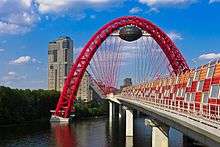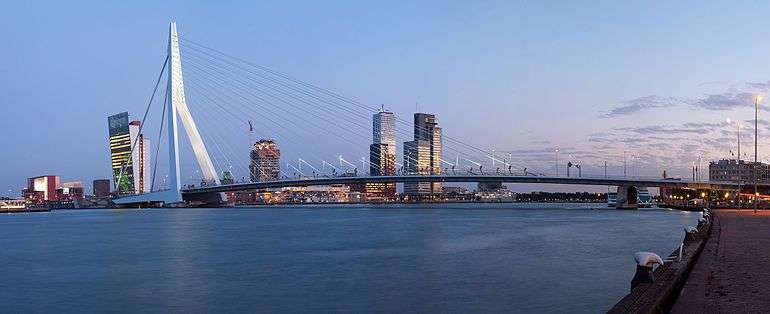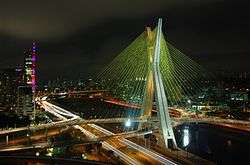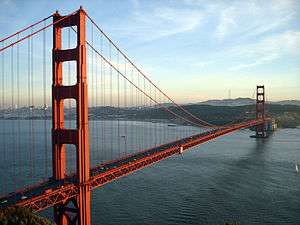Cable-stayed bridge
|
The Russky Bridge's central span measures 1104 meters. It is the world's longest cable-stayed bridge. | |
| Ancestor | Suspension bridge |
|---|---|
| Related | Extradosed bridge |
| Descendant | Side-spar cable-stayed bridge, Self-anchored suspension bridge, cantilever spar cable-stayed bridge |
| Carries | Pedestrians, bicycles, automobiles, trucks, light rail |
| Span range | Medium to Long |
| Material | Steel rope, post-tensioned concrete box girders, steel or concrete pylons |
| Movable | No. |
| Design effort | medium |
| Falsework required | Normally none |
A cable-stayed bridge has one or more towers (or pylons), from which cables support the bridge deck. A distinctive feature are the cables which run directly from the tower to the deck, normally forming a fan-like pattern or a series of parallel lines. This is in contrast to the modern suspension bridge, where the cables supporting the deck are suspended vertically from the main cable, anchored at both ends of the bridge and running between the towers. The cable-stayed bridge is optimal for spans longer than cantilever bridges, and shorter than suspension bridges. This is the range where cantilever bridges would rapidly grow heavier if the span were lengthened, while suspension bridge cabling would not be more economical if the span were shortened.
Cable-stayed bridges have been known since the 16th century and used widely since the 19th. Early examples often combined features from both the cable-stayed and suspension designs, including the famous Brooklyn Bridge. The design fell from favor through the 20th century as larger gaps were bridged using pure suspension designs, and shorter ones using various systems built of reinforced concrete. It once again rose to prominence in the later 20th century when the combination of new materials, larger construction machinery, and the need to replace older bridges all lowered the relative price of these designs.
History

Cable-stayed bridges date back to 1595, where designs were found in Machinae Novae, a book by Croatian inventor Fausto Veranzio. Many early suspension bridges were cable-stayed construction, including the 1817 footbridge Dryburgh Abbey Bridge, James Dredge's patented Victoria Bridge, Bath (1836), and the later Albert Bridge (1872) and Brooklyn Bridge (1883). Their designers found that the combination of technologies created a stiffer bridge. John A. Roebling took particular advantage of this to limit deformations due to railway loads in the Niagara Falls Suspension Bridge.
The earliest known surviving example of a true cable-stayed bridge in the United States is E.E. Runyon's largely intact steel or iron bridge with wooden stringers and decking in Bluff Dale, Texas (1890), or his weeks-earlier but ruined Barton Creek Bridge between Huckabay, Texas and Gordon, Texas (1889 or 1890).[1][2] In the twentieth century, early examples of cable-stayed bridges included A. Gisclard's unusual Cassagnes bridge (1899),[3] in which the horizontal part of the cable forces is balanced by a separate horizontal tie cable, preventing significant compression in the deck, and G. Leinekugel le Coq's bridge[4] at Lézardrieux in Brittany (1924). Eduardo Torroja designed a cable-stayed aqueduct[5] at Tempul in 1926.[6] Albert Caquot's 1952 concrete-decked cable-stayed bridge[7] over the Donzère-Mondragon canal at Pierrelatte is one of the first of the modern type, but had little influence on later development.[6] The steel-decked Strömsund Bridge designed by Franz Dischinger (1955) is therefore more often cited as the first modern cable-stayed bridge.
Other key pioneers included Fabrizio de Miranda, Riccardo Morandi and Fritz Leonhardt. Early bridges from this period used very few stay cables, as in the Theodor Heuss Bridge (1958). However, this involves substantial erection costs, and more modern structures tend to use many more cables to ensure greater economy.
Comparison with suspension bridge

Cable-stayed bridges may appear to be similar to suspension bridges, but in fact they are quite different in principle and in their construction.
In suspension bridges, large main cables (normally two) hang between the towers and are anchored at each end to the ground. This can be difficult to implement when ground conditions are poor. The main cables, which are free to move on bearings in the towers, bear the load of the bridge deck. Before the deck is installed, the cables are under tension from their own weight. Along the main cables smaller cables or rods connect to the bridge deck, which is lifted in sections. As this is done, the tension in the cables increases, as it does with the live load of traffic crossing the bridge. The tension on the main cables is transferred to the ground at the anchorages and by downwards tug on the towers.
- Difference between types of bridges
-

Suspension bridge
-

Cable-stayed bridge, fan design
In the cable-stayed bridge, the towers are the primary load-bearing structures which transmit the bridge loads to the ground. A cantilever approach is often used to support the bridge deck near the towers, but lengths further from them are supported by cables running directly to the towers. This has the disadvantage, compared to the suspension bridge, that the cables pull to the sides as opposed to directly up, requiring the bridge deck to be stronger to resist the resulting horizontal compression loads; but has the advantage of not requiring firm anchorages to resist the horizontal pull of the main cables of the suspension bridge. By design all static horizontal forces of the cable-stayed bridge are balanced so that the supporting towers do not tend to tilt or slide, needing only to resist horizontal forces from the live loads.
Key advantages of the cable-stayed form are as follows:
- much greater stiffness than the suspension bridge, so that deformations of the deck under live loads are reduced
- can be constructed by cantilevering out from the tower – the cables act both as temporary and permanent supports to the bridge deck
- for a symmetrical bridge (i.e. spans on either side of the tower are the same), the horizontal forces balance and large ground anchorages are not required
Designs
There are four major classes of rigging on cable-stayed bridges: harp, mono, star and fan.[8]
- The mono design uses a single cable from its towers, and is one of the lesser-used examples of the class.
- In the harp or parallel design, the cables are nearly parallel so that the height of their attachment to the tower is proportional to the distance from the tower to their mounting on the deck.
- In the fan design, the cables all connect to or pass over the top of the towers. The fan design is structurally superior with minimum moment applied to the towers but for practical reasons the modified fan is preferred especially where many cables are necessary. In the modified fan arrangement the cables terminate near to the top of the tower but are spaced from each other sufficiently to allow better termination, improved environmental protection, and good access to individual cables for maintenance.
- In the star design, another relatively rare design, the cables are spaced apart on the tower, like the harp design, but connect to one point or a number of closely spaced points on the deck.[9]
- Difference between types of bridges
-

Cable-stayed bridge, fan design
-

Cable-stayed bridge, harp design
There are also four arrangements for support columns: single, double, portal and A-shaped.[8]
- The single arrangement uses a single column for cable support, normally projecting through the center of the deck, but in some cases located on one side or the other.
- The double arrangement places pairs of columns on both sides of the deck.
- The portal is similar to the double arrangement, but has a third member connecting the tops of the two columns to form a door-like shape, or portal. This offers additional strength, especially against traverse loads.
- The A-shaped design is similar in concept to the portal, but achieves the same goal by angling the two columns towards each other to meet at the top, eliminating the need for the third member. The inverted Y design combines the A-shaped on the bottom with the single on top.
Depending on the design, the columns may be vertical or angled or curved relative to the bridge deck.
Variations
Side-spar cable-stayed bridge
A side-spar cable-stayed bridge uses a central tower supported on only one side. This design allows the construction of a curved bridge.
Cantilever-spar cable-stayed bridge
Far more radical in its structure, the Puente del Alamillo (1992) uses a single cantilever spar on one side of the span, with cables on one side only to support the bridge deck. Unlike other cable-stayed types, this bridge exerts considerable overturning force upon its foundation and the spar must resist the bending caused by the cables, as the cable forces are not balanced by opposing cables. The spar of this particular bridge forms the gnomon of a large garden sundial. Related bridges by the architect Santiago Calatrava include the Puente de la Mujer (2001), Sundial Bridge (2004), Chords Bridge (2008), and Assut de l'Or Bridge (2008).
Multiple-span cable-stayed bridge

Cable-stayed bridges with more than three spans involve significantly more challenging designs than do 2-span or 3-span structures.
In a 2-span or 3-span cable-stayed bridge, the loads from the main spans are normally anchored back near the end abutments by stays in the end spans. For more spans, this is not the case and the bridge structure is less stiff overall. This can create difficulties in both the design of the deck and the pylons. Examples of multiple-span structures in which this is the case include Ting Kau Bridge, where additional 'cross-bracing' stays are used to stabilise the pylons; Millau Viaduct and Mezcala Bridge, where twin-legged towers are used; and General Rafael Urdaneta Bridge, where very stiff multi-legged frame towers were adopted. A similar situation with a suspension bridge is found at both the Great Seto Bridge and San Francisco–Oakland Bay Bridge where additional anchorage piers are required after every set of three suspension spans – this solution can also be adapted for cable-stayed bridges.[10]
Extradosed bridge

The extradosed bridge is a cable-stayed bridge but with a more substantial bridge deck that, being stiffer and stronger, allows the cables to be omitted close to the tower and for the towers to be lower in proportion to the span. The first extradosed bridges were the Ganter Bridge and Sunniberg Bridge in Switzerland. A new extradosed bridge is also being planned to cross the St. Croix River between Bayport, Minnesota and Houlton, Wisconsin in the Twin Cities.
Cable-stayed cradle-system bridge
A cradle system carries the strands within the stays from bridge deck to bridge deck, as a continuous element, eliminating anchorages in the pylons. Each epoxy-coated steel strand is carried inside the cradle in a one-inch (2.54 cm) steel tube. Each strand acts independently, allowing for removal, inspection and replacement of individual strands. The first two such bridges are the Penobscot Narrows Bridge, completed in 2006, and the Veterans' Glass City Skyway, completed in 2007.[11]
Related bridge types
Self anchored suspension bridge
A self-anchored suspension bridge has some similarity in principle to the cable-stayed type in that tension forces that prevent the deck from dropping are converted into compression forces vertically in the tower and horizontally along the deck structure. It is also related to the suspension bridge in having arcuate main cables with suspender cables, although the self-anchored type lacks the heavy cable anchorages of the ordinary suspension bridge. Unlike either a cable stayed bridge or a suspension bridge, the self-anchored suspension bridge must be supported by falsework during construction and so it is more expensive to construct.
Notable cable-stayed bridges
See also: List of longest cable-stayed bridge spans and Category:Cable-stayed bridges
- Brooklyn Bridge, famous as a suspension bridge, also has cable stays.
- Centennial Bridge, a six-lane vehicular bridge that crosses the Panama Canal with a total length of 1.05 kilometres (3,400 ft).

- Erasmus Bridge crosses the Nieuwe Maas in Rotterdam, Netherlands. The southern span of the bridge has an 89 metres (292 ft) bascule bridge for ships that cannot pass under the bridge. The bascule bridge is the largest and heaviest in West Europe and has the largest panel of its type in the world.
- Golden Horn Metro Bridge, connects the old peninsula of Istanbul with the Galata district and is the first cable-stayed bridge in Turkey.
- Jiaxing-Shaoxing Sea Bridge, Zhejiang Province, China. The bridge is an eight lane structure that spans 10,100 metres (6.3 mi) across Hangzhou Bay, connecting Jiaxing and Shaoxing, two cities of Zhejiang province. It was opened on 23 July 2013 and is currently the longest cable-stayed bridge in the world.
- John James Audubon Bridge (Mississippi River): The longest cable-stayed bridge in the Western Hemisphere, crossing the Mississippi River between New Roads, Louisiana and St. Francisville, Louisiana.
- Lyne Bridge, crosses the M25 motorway near Chertsey, England, 1979, is one of the few cable-stayed bridges to carry a heavy railway (the Chertsey Branch Line).[12]
- Millau Viaduct, the bridge with the tallest piers in the world: 341 metres (1,119 ft) tall and roadway 266 metres (873 ft) high, spanning the Tarn River in France. With a total length of 2,460 metres (8,070 ft) and seven towers, it also has the longest cable-stayed suspended deck in the world.
- Most SNP (Nový most), the world's longest cable-stayed bridge in category with one pylon and with one cable-stayed plane, spanning the Danube in Bratislava, Slovakia. The main span is 303 metres (994 ft), total length 430.8 metres (1,413 ft). The only member of World Federation of Great Towers that is primarily used as a bridge. It houses a flying-saucer restaurant at the top of pylon 85 metres (279 ft) tall.

- Octavio Frias de Oliveira bridge, crosses the Pinheiros River in São Paulo, 2008. It has a 138 metres (453 ft)-high pylon under which two stayed roads cross each other turning 90° to the opposite bank of the river.
- Oresund Bridge, a combined two-track rail and four-lane road bridge with a main span of 490 metres (1,610 ft) and a total length of 7.85 kilometres (4.88 mi), crossing the Öresund between Malmö, Sweden and the Danish Capital Region.
- Pont de Normandie, crosses the Seine in Normandy, France – briefly the world's longest cable-stayed bridge.
- Queensferry Crossing (formerly the Forth Replacement Crossing) is a road bridge under construction in Scotland. It is being built alongside the existing, suspension, Forth Road Bridge across the Firth of Forth.
- Rande Bridge in Spain near Vigo is the highway cable-stayed bridge with the longest and slenderest span in the world at the time of construction (1973–1977). Three long spans of 148 metres (486 ft) + 400 metres (1,300 ft) + 148 metres (486 ft). Pylons in concrete, girder in steel.
- Rio-Antirio bridge, crosses the Gulf of Corinth near Patras, Greece. At a total length of 2,880 metres (9,450 ft) and four towers, it has the second longest cable-stayed suspended deck (2,258 metres (7,408 ft) long) in the world, with only the deck of the Millau Viaduct in southern France being longer at 2,460 metres (8,070 ft). However, as the latter is also supported by bearings at the pylons apart from cable stays, the Rio–Antirrio bridge deck might be considered the longest cable-stayed fully suspended deck in the world.
- Russky Bridge, the cable-stayed bridge with the world’s longest span, at 1,104 metres (3,622 ft) meters. Vladivostok, Russia.
- Second Severn Crossing between England and Wales is 3.186 miles (5.127 km) long, consisting of a single central navigation span over the "Shoots" channel and approach viaducts on either side. The Second Severn Crossing Bridge uses Freyssinet cable stays.
- Sunshine Skyway Bridge, the world's longest bridge with a cable-stayed main span; carries I-275 across Tampa Bay south of St. Petersburg, Florida, United States. The very similar looking Oresund bridge is slightly shorter but has a longer main span.
- Surgut Bridge, the longest single-pylon cable-stayed bridge in the world, crossing the Ob River in Siberia, Russia.
- Sutong Yangtze River Bridge in eastern China has the second longest cable-stayed bridge span at 1,088 metres (3,570 ft). Completed in 2008, the Sutong Bridge is one of over 40 cable-stayed bridges built over the Yangtze since 1995.
- Ting Kau Bridge, the world's first major four-span (three towers) cable-stayed bridge, forming part of the road network connecting Hong Kong International Airport to other parts of Hong Kong, China.

- Vasco da Gama Bridge in Lisbon, Portugal is the longest bridge in Europe, with a total length of 17.2 kilometres (10.7 mi), including 0.829 kilometres (0.515 mi) for the main bridge, 11.5 kilometres (7.1 mi) in viaducts and 4.8 kilometres (3.0 mi) in extension roads.
- The Leonard P. Zakim Bunker Hill Memorial Bridge in downtown Boston, Massachusetts spanning the Charles River is the cable-stayed bridge with the world's widest roadbed for such a bridge, at some 183 feet (56 m), encompassing ten lanes of traffic.
- Zárate–Brazo Largo Bridges over the Paraná Guazú and Paraná de las Palmas Rivers in Argentina (1972–1976) are the first two road and railway long-span cable-stayed steel bridges in the world. Spans: 110 metres (360 ft) + 330 metres (1,080 ft) + 110 metres (360 ft).
References
- ↑ "Bluff Dale Suspension Bridge". Historic American Engineering Record. Library of Congress.
- ↑ "Barton Creek Bridge". Historic American Engineering Record. Library of Congress.
- ↑ 42°30′14″N 2°08′37″E / 42.5040°N 2.1436°E
- ↑ 48°46′51″N 3°06′24″W / 48.7807°N 3.1065345°W
- ↑ 36°38′56″N 5°55′49″W / 36.64876°N 5.9304°W
- 1 2 Troyano, Leonardo (2003). Bridge Engineering: A Global Perspective. Thomas Telford. pp. 650–652. ISBN 0-7277-3215-3.
- ↑ 44°22′57″N 4°43′42″E / 44.3824°N 4.7284°E
- 1 2 "Cable Stayed Bridge". Middle East Economic Engineering Forum.
- ↑ T.K. Bandyopadhyay; Alok Baishya (2000). P. Dayaratnam; G.P. Garg; G.V. Ratnam; R.N. Raghavan, eds. International Conference on Suspension, Cable Supported, and Cable Stayed Bridges: November 19-21, 1999, Hyderabad. Universities Press (India). pp. 282, 373. ISBN 978-81-7371-271-5.
- ↑ Virlogeux, Michel (1 February 2001). "Bridges with multiple cable-stayed spans". Structural Engineering International. 11 (1): 61–82. doi:10.2749/101686601780324250. Retrieved 8 March 2008.
- ↑ "Bridging To The Future Of Engineering" (Press release). American Society of Civil Engineers. 12 March 2007. Retrieved 8 March 2008.
- ↑ "Lyne Bridge, Chertsey - Railway Structures". Southern E-Group. Retrieved 30 August 2013.
Further reading
- De Miranda F., et al., (1979), "Basic problems in long span cable stayed bridges", Rep. n. 25, Dipartimento di Strutture – Università di Calabria – Arcavacata (CS) Italy, (242 pagg.) September 1979.
- Gregory, Frank Hutson; Freeman, Ralph Anthony (1987). The Bangkok Cable Stayed Bridge. 3 F Engineering Consultants, Bangkok. ISBN 974-410-097-4.
- Podolny, Walter; Scalzi, John B. (1986). Construction and design of cable-stayed bridges (2nd ed.). New York: Wiley. ISBN 0471826553.*
- Walther, Rene; et al. (1999). Cable Stayed Bridges (2nd ed.). Thomas Telford. ISBN 0-7277-2773-7.
External links
| Wikimedia Commons has media related to Cable-stayed bridges. |

.jpg)
